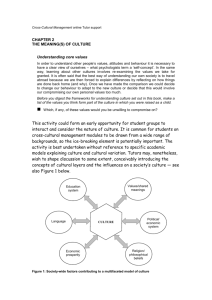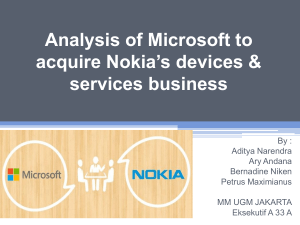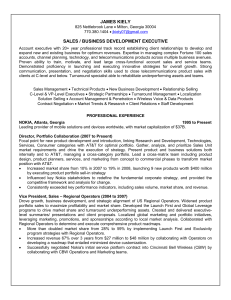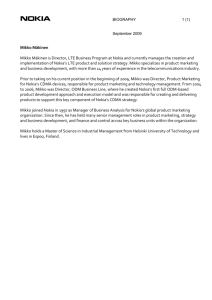The success of Nokia during industry slowdown
advertisement
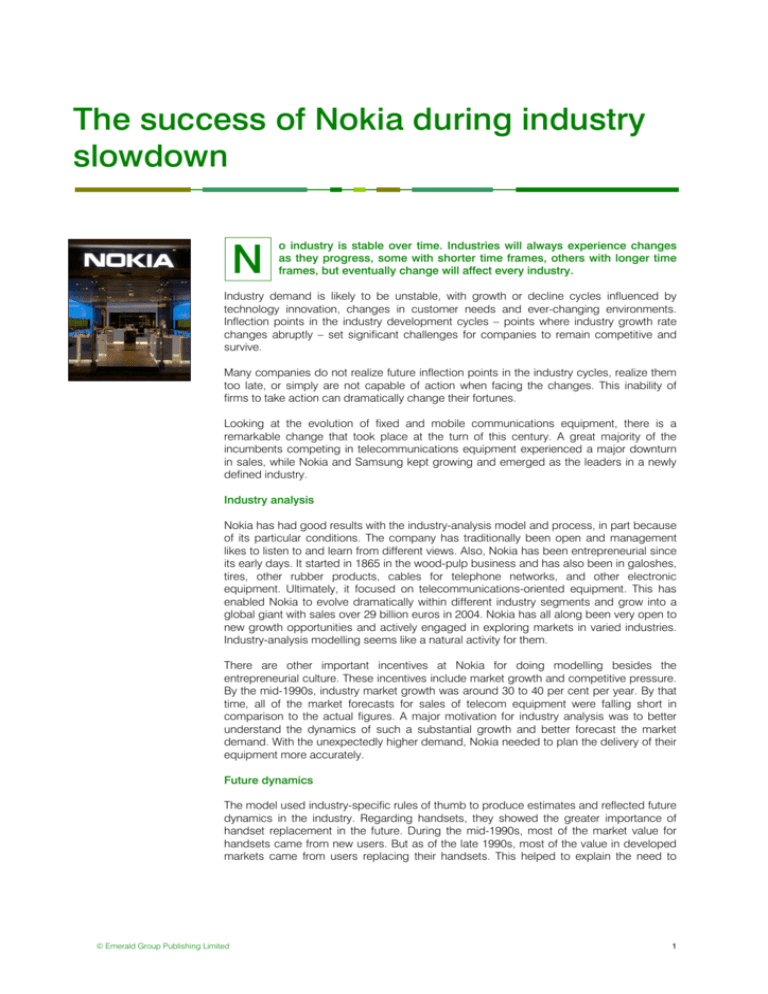
The success of Nokia during industry slowdown N o industry is stable over time. Industries will always experience changes as they progress, some with shorter time frames, others with longer time frames, but eventually change will affect every industry. Industry demand is likely to be unstable, with growth or decline cycles influenced by technology innovation, changes in customer needs and ever-changing environments. Inflection points in the industry development cycles – points where industry growth rate changes abruptly – set significant challenges for companies to remain competitive and survive. Many companies do not realize future inflection points in the industry cycles, realize them too late, or simply are not capable of action when facing the changes. This inability of firms to take action can dramatically change their fortunes. Looking at the evolution of fixed and mobile communications equipment, there is a remarkable change that took place at the turn of this century. A great majority of the incumbents competing in telecommunications equipment experienced a major downturn in sales, while Nokia and Samsung kept growing and emerged as the leaders in a newly defined industry. Industry analysis Nokia has had good results with the industry-analysis model and process, in part because of its particular conditions. The company has traditionally been open and management likes to listen to and learn from different views. Also, Nokia has been entrepreneurial since its early days. It started in 1865 in the wood-pulp business and has also been in galoshes, tires, other rubber products, cables for telephone networks, and other electronic equipment. Ultimately, it focused on telecommunications-oriented equipment. This has enabled Nokia to evolve dramatically within different industry segments and grow into a global giant with sales over 29 billion euros in 2004. Nokia has all along been very open to new growth opportunities and actively engaged in exploring markets in varied industries. Industry-analysis modelling seems like a natural activity for them. There are other important incentives at Nokia for doing modelling besides the entrepreneurial culture. These incentives include market growth and competitive pressure. By the mid-1990s, industry market growth was around 30 to 40 per cent per year. By that time, all of the market forecasts for sales of telecom equipment were falling short in comparison to the actual figures. A major motivation for industry analysis was to better understand the dynamics of such a substantial growth and better forecast the market demand. With the unexpectedly higher demand, Nokia needed to plan the delivery of their equipment more accurately. Future dynamics The model used industry-specific rules of thumb to produce estimates and reflected future dynamics in the industry. Regarding handsets, they showed the greater importance of handset replacement in the future. During the mid-1990s, most of the market value for handsets came from new users. But as of the late 1990s, most of the value in developed markets came from users replacing their handsets. This helped to explain the need to © Emerald Group Publishing Limited 1 constantly innovate on features and styles to encourage existing users to replace their phones more. Concerning infrastructure, some significant dynamics in network evolution were identified. The economics of network construction from the first stages of coverage to capacity and thereafter to enhancements was identified. The initial network coverage needs significant investments. But another cycle of even more substantial equipment demand comes from increased traffic. That traffic initially was impacted in the 1990s with an explosive growth of new mobile phone users. But as the user base consolidated, the main driver for traffic increase came from increased traffic by existing users. This reinforced the need to encourage users to use their phones more. Besides the handset and infrastructure sales dynamics, there were also dynamics observed in operator customers, mobile phone users, and mobile equipment technology. Operator customers consisted at first of national incumbents and, in some countries, new entrants. As time went on and regulators liberalized the mobile market in different countries, most of the growth came from new operators competing to provide mobile communications systems. This was a new segment of operator customers that Nokia focused on. As liberalization continued, again the industry structure changed. Operators started going international. Major international operators such as Vodafone, NTT DoCoMo, Telefonica, Deutsche Telecom, Hutchison, France Telecom and others became global players. The changes in the operator industry structure demanded that equipment suppliers focus their organizations and sales effort to supply these specific customer groups better to develop customer bonding and customer lock-ins. Nokia was able to satisfy existing customers and gain new ones within a strategic setting. There were also important changes in mobile user segments. Mobile telephony started as a service for niche segments able to pay for the expensive service. As penetration of mobile telephony increased, better economies of scale were realized and prices dropped, spurring the emergence of new mobile phone user segments. Segments such as professionals, young people, women, and fashion-oriented persons emerged. Together, Nokia and the operators developed new services for these emerging segments. Mobile communications technology also changed from first generation analogue systems to digital second generation systems. By 2000, third generation systems started to emerge. New technologies offered advantages such as more capacity, better services, and ultimately mobile multimedia services. The dynamics were easier to predict globally since some of these trends appeared first in lead markets such as Finland where penetration was the highest in the world and where Nokia is headquartered. Understanding the industry dynamics in lead markets before they spread and applying that knowledge in the strategy process was very important for Nokia. Acting before a slowdown occurs Taking strategic actions consistent with industry dynamics and inflection points allowed Nokia to become the most prominent mobile equipment supplier by 2000. As a result of modelling the industry demand, Nokia forecast in 1998 that there would be a market slowdown within three to four years. The data generated controversy at Nokia because people were thinking only about how to grow faster. Nokia was half the size of competitors in terms of headcount. Most departments were demanding resources to cope with the increasing sales and workload. The organization attributed its success not only to its great products and customer-service focus but also to the speedy response to growth and its ability to expand logistics. Telling people to go in the other direction and prepare for a slowdown seemed foolish. But the firm needed to assess their scale of operations well before a major change in demand happened. While the internal communication exercises were going on at Nokia, the industry was convinced that growth would continue for a long time. Most of the competitors, customers, and analysts gave upbeat reports on industry development. They asked: what indications 2 © Emerald Group Publishing Limited showed that a slowdown would become a trend? The answer appeared in the lead market of Finland. As mobile penetration surpassed 60 per cent of the population, investment patterns for network infrastructure equipment changed. Operators reduced their investment in network infrastructure equipment according to their needs. Also, the handset market started to switch from handsets sold to new subscribers to handsets sold as replacements. So the evidence was there. Management got the message. Two to three years before the global slowdown, Nokia was ready. The firm was much better prepared than its main competitors, and the scale of operations grew according to the conditions expected. Nokia was also able to influence the key dynamics for not decreasing sales as much as its main competitors, even though it was smaller. Nokia was able to act on the demand drivers to boost handset replacement sales by integrating innovations in the handsets; including new fashionable designs, messaging capabilities, colour screens, cameras, fold designs, as well as phones with newer technology. Regarding infrastructure, Nokia was able to launch new solutions, as with next generation mobile technologies GSM-EDGE and WCDMA, to penetrate new markets, and boost infra investments by increased usage by individuals. Understanding industry evolution It is important to mention that communicating important changes in the industry cycles is not an easy task. It is very difficult to predict industry cycles by interpreting early signs and uncertain data. Understanding the lead markets, in this case Finland, helped. There are implementation challenges, as well, in terms of strategy and leadership. Top management must get the message across to the organization and persuade people to act upon it. There were also challenges regarding structure and process. People in the organization felt that they were being removed from their familiar structures. When Nokia restructured sales and marketing by focusing on the largest global customers and consolidated operations, customer consolidations, uncertainty and anxiety resulted. As a result of applying the framework, Nokia was able to scale its operations to be better prepared for future competition. In comparison with other players, Nokia has grown in step with industry demand. It has been more rational and has experienced fewer fluctuations than peers who were late in adjusting to the actual industry cycles. Competitors may achieve some streamlining and focus by their reductions, but dramatic downsizing can do more harm than good. It is expensive to hire personnel that later will be let go. Downsizing hurts morale and causes other internal difficulties. A good understanding of industry evolution can prevent such abrupt decisions. April 2009. This is a shortened version of "Nokia: a case study in managing industry downturn", which originally appeared in the Journal of Business Strategy, Volume, 29 Number, 1, 2008. The authors are Raúl Carral and Markus Kajanto. © Emerald Group Publishing Limited 3

